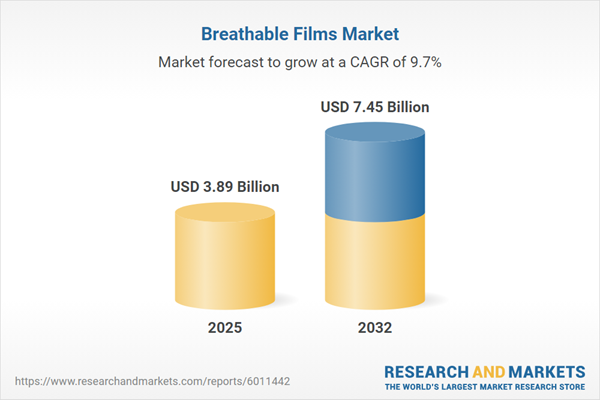Speak directly to the analyst to clarify any post sales queries you may have.
The breathable films market is rapidly evolving, shaped by rising performance demands, sustainability imperatives, and dynamic regulatory shifts across major industries. Senior leaders seeking to align strategy with advanced material technologies and resilient supply chains will find actionable insights throughout this research-driven analysis.
Market Snapshot: Breathable Films Market Growth and Trends
The breathable films market grew from USD 3.55 billion in 2024 to USD 3.89 billion in 2025. It is expected to continue expanding at a CAGR of 9.71%, reaching USD 7.45 billion by 2032. This trajectory is fueled by industries adopting high-performance moisture management solutions that do not compromise durability. Material science advancements are enabling applications from athletic footwear and medical garments to construction membranes, further stimulating market momentum.
Scope & Segmentation: In-Depth Market Coverage
- Product Types: Microporous films offer enhanced water vapor transmission for applications like activewear and medical disposables, while monolithic films deliver moisture wicking and robust weather resistance for footwear and protective clothing.
- Raw Materials:
- High Density Polyethylene delivers superior strength and chemical resistance.
- Low Density Polyethylene provides flexibility and cost efficiency.
- Polyurethane adds elasticity and abrasion resistance.
- Polyvinyl Chloride enables flame retardancy for specialized industrial uses.
- Applications:
- Construction membranes for building envelope moisture management
- Footwear including athletic, casual, and protective shoes
- Industrial protective clothing
- Medical drapes and disposables
- Sales Channels:
- Offline: Distributors, modern trade partners, specialty stores
- Online: Direct-to-consumer platforms, e-commerce marketplaces
- Regional Coverage:
- Americas: North America (US, Canada, Mexico), Latin America (Brazil, Argentina, Chile, Colombia, Peru)
- Europe, Middle East & Africa: Europe (UK, Germany, France, Russia, Italy, Spain, Netherlands, Sweden, Poland, Switzerland), Middle East (UAE, Saudi Arabia, Qatar, Turkey, Israel), Africa (South Africa, Nigeria, Egypt, Kenya)
- Asia-Pacific: China, India, Japan, Australia, South Korea, Indonesia, Thailand, Malaysia, Singapore, Taiwan
- Key Companies: The Dow Chemical Company, Exxon Mobil Corporation, BASF SE, Mitsui Chemicals Inc., Berry Global Inc., Tredegar Corporation, Toray Industries Inc., Cosmo Films Limited, JSP Corporation, LINTEC Corporation
Key Takeaways for Decision Makers
- Advanced material technologies—such as microencapsulation and nanofiber structures—are refining moisture control and user comfort across expanding end-use sectors.
- Regulatory trends and regional mandates are accelerating the adoption of eco-friendly, recyclable, and bio-based polymer solutions across supply chains.
- Integration of Industry 4.0 and digital manufacturing innovations is enhancing quality, consistency, and process efficiency, enabling rapid product innovation.
- Strategic moves, including partnerships and vertical integration, are fostering portfolio diversification and proximity to key end markets for improved responsiveness.
- Tariff revisions, especially in the United States, are reshaping material sourcing and cost structures, prompting regionalization and forward procurement strategies.
- Segment adoption varies: construction and medical segments prioritize robust barrier properties, while the footwear and apparel sectors demand comfort and breathability.
Tariff Impact: Navigating Trade Policy Disruptions
Ongoing and future US tariff adjustments are affecting the flow of resin imports and multilayer laminates, raising input costs for domestic converters. Industry stakeholders are responding by localizing production, negotiating new supplier arrangements, and exploring alternative polymer blends. These moves are aimed at preserving competitiveness and maintaining access to essential raw materials despite trade volatility.
Methodology & Data Sources
This report blends primary expert interviews, patent analysis, regulatory reviews, and quantitative database synthesis to ensure comprehensive coverage. Field visits and roundtables with value chain stakeholders provide direct observation of process innovation and quality assurance, underpinning the reliability of findings.
Why This Report Matters: Strategic Outcomes for Leaders
- Informs critical decisions on material innovation, supply chain resilience, and adoption of digital manufacturing.
- Enables precise market positioning by mapping technology trends and emerging regional demand drivers.
- Prepares stakeholders for regulatory shifts and evolving end-use requirements across global clusters.
Conclusion
As the breathable films sector transforms through technological progress and evolving policies, aligning with advanced materials and data-driven manufacturing will be key. Leaders relying on this report can adeptly navigate complexity, capitalize on growth, and fortify their competitive position.
Additional Product Information:
- Purchase of this report includes 1 year online access with quarterly updates.
- This report can be updated on request. Please contact our Customer Experience team using the Ask a Question widget on our website.
Table of Contents
3. Executive Summary
4. Market Overview
7. Cumulative Impact of Artificial Intelligence 2025
Companies Mentioned
The companies profiled in this Breathable Films market report include:- The Dow Chemical Company
- Exxon Mobil Corporation
- BASF SE
- Mitsui Chemicals, Inc.
- Berry Global, Inc.
- Tredegar Corporation
- Toray Industries, Inc.
- Cosmo Films Limited
- JSP Corporation
- LINTEC Corporation
Table Information
| Report Attribute | Details |
|---|---|
| No. of Pages | 192 |
| Published | October 2025 |
| Forecast Period | 2025 - 2032 |
| Estimated Market Value ( USD | $ 3.89 Billion |
| Forecasted Market Value ( USD | $ 7.45 Billion |
| Compound Annual Growth Rate | 9.7% |
| Regions Covered | Global |
| No. of Companies Mentioned | 11 |









